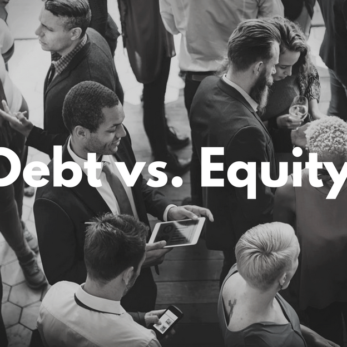What you will learn:
A deep dive into the secondary market for crowdfunded investments
The crowdfunding sector continues to evolve by taking innovative forms.
Even a year ago, we couldn’t imagine the possibility of reselling private equity investments merely because there was no market for such deals.
Owing to the efforts applied by several crowdfunding platforms, the secondary market for equity investments was finally started up, and the majority of investors rejoiced.
Why?
Because now they can get rid of unwanted or super risky investments by trading them.
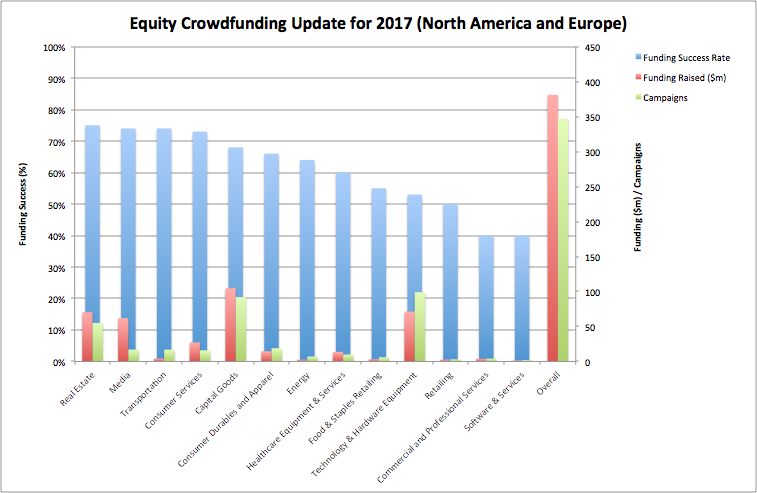
First things first – let’s figure out how equity crowdfunding works.
Equity crowdfunding is one of the ways to raise funds if you’re a startup and invest money in a business if you’re a backer.
A large crowd provides a business with a start capital needed for its realisation by means of purchasing its shares.
Equity crowdfunding is understood as an alternative to the rewards-based and donation-based patterns whereby investors get pre-order items or lend money to businesses almost for no return.
Equity crowdfunding is a perfect solution for companies willing to transfer their ownership rights, startups who have a great business proposal and those companies who expect the 5X return.
If you’re an accredited investor contemplating funding a startup, consider the pros and cons of this financial undertaking.
Benefits and limitations of the equity crowdfunding market for investors
- The process is open and transparent with no catches and pitfalls due to the robust legislation base.
- You get a chance to invest in a startup with huge potential and promising prospects. For those angel investors who are passionate about some trends, there is an excellent opportunity to support them.
- Successful projects give high returns, and you may be lucky to get them. For example, real estate projects are considered to be very profitable, although there is a high probability that your investments are not going to pay off. Consider the reality of the risk and the efficacy of the business and marketing plans carefully.
- Your investment income can be significantly reduced according to the Enterprise Investment Scheme (EIS) or the Seed Enterprise Investment Scheme (SEIS).
- Alongside high returns, you have to accept high risks. Not putting all the eggs in one basket can be a probable way out. If you do buy risky shares, divide your money between various projects.
- Crowdfunding investments are thought to be illiquid, which means they are tough to resell. In different scenarios, you will have to hold shares until either a business goes bankrupt or it is acquired by a larger investor or the shares of a business are listed on the stock exchange.
The emergence of secondary markets for equity crowdfunding is going to eliminate the last disadvantage.
How does equity crowdfunding work?
In a nutshell, the process goes through several stages:
- A potential candidate applies to be shortlisted on a crowdfunding platform.
- The fundraising company conducts due diligence checks and decides whether the candidate meets requirements.
- The project is presented on the platform, and prospective investors are invited to support it.
- The fundraising company creates a Special Purpose Vehicle (SPV) aka a Limited Company and investors become shareholders in its capital structure.
- Each investment is tracked, and backers are provided with reports regularly. Borrowers actively communicate with the pool of investors to ensure them the project is on its way to success.
- Investors can hold their shares until the exit of the campaign or resell them on the secondary market. At the end of the campaign, investors gain the profits generated by the project.
Equity crowdfunding secondary market – what exactly is it?
We like the definition of the secondary market presented in this article by David M. Freedman, as it explains the sense of the notion clearly and correctly.
Before the emergence of the secondary market, all private equities were entirely illiquid.
What does it mean?
They were frozen for the one year under JOBS Act Title III and could either be sold or donated only to their issuer, an accredited investor (don’t mix it up with a non-accredited one), your family member.
There was an option for them to be traded as a registered offering via the SEC within this period.
However, now and then it happens that an investor may be looking for the ways of exchanging their securities for cash.
The introduction of a secondary market has given investors an excellent chance to update their portfolio and participate in lucrative deals.
Several equity crowdfunding projects are presenting secondary markets for their investors.
The pioneer was Seedrs announcing opening its secondary market a year ago.
Despite the number of unsuccessful projects on launching secondary markets, Seedrs and its major rival Crowdcube have already proved that their efforts were not in vain.

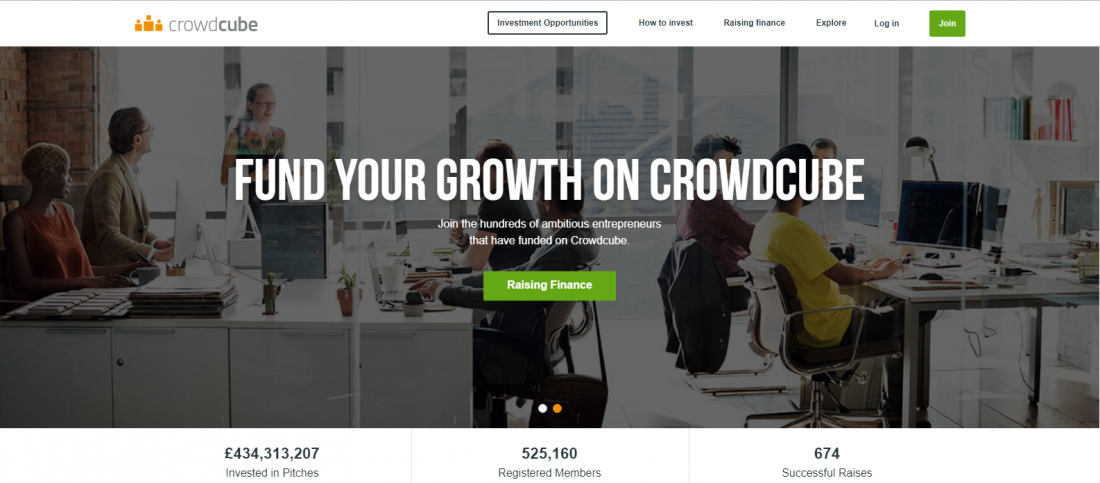
Seedrs: equity crowdfunding secondary market
In general, crowdfunding platforms with secondary markets function simply – they allow the accredited investors who purchased shares via these portals to trade them in the marketplace.
Some of them, e.g. Symbid, have gone further and even have made the market accessible for non-accredited investors.
Seedrs, a crowdfunding platform operating in Great Britain, was the first to launch the secondary market for crowdfunding investors in summer 2017.
As of today, it’s open only for Seedrs’ clients and enables them to increase their ownership rights.
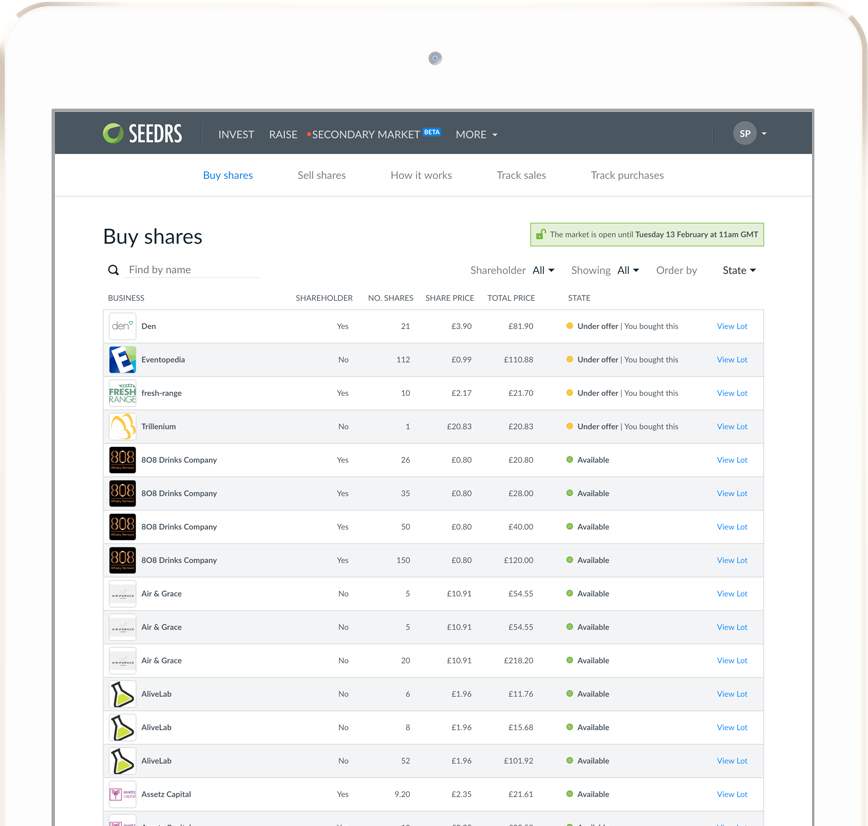
Seedrs itself set the fair price for traded stakes according to their Valuation Policy.
Supply and demand determine the price for a particular shares lot.
Seedrs works as a nominee for its backers, which means the portal holds all the shares and takes care of the whole administrative process.
Trading sessions are held only once a month – within a one-week time starting on the first Tuesday of every month.
After each “Trading Tuesday, the company deals with all the paperwork from the previous session and gets lots prepared for a new one.
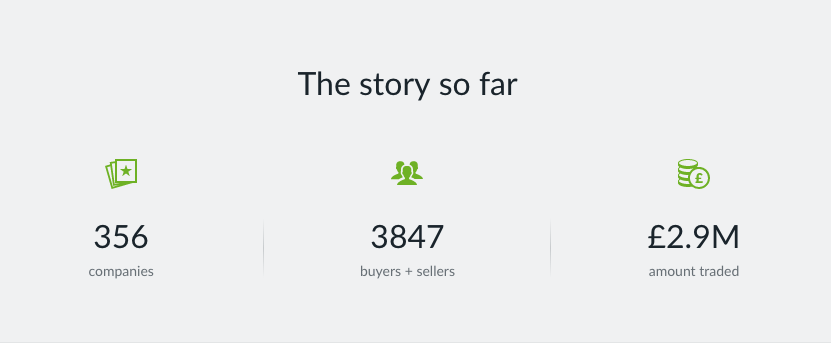
According to the Seedrs official website, more than 365 companies and about 3847 individual buyers and sellers have participated in trading transactions for an amount of £2.9M throughout the first year of its operation.
If you are an investor unwilling to wait for a new funding round, you can try your luck and purchase a share lot in the secondary market.
Once you’ve paid for a lot, you will need to sign an agreement sent to you by the mediator.
As soon as all the paperwork is done, the shares will be added to your investment portfolio.
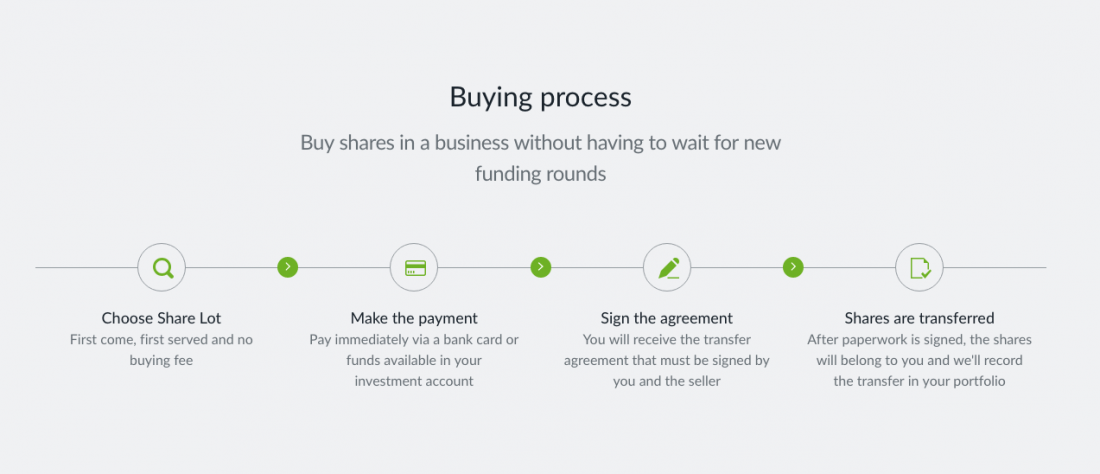
Those investors who seek an opportunity to gain returns without waiting until the business starts to float on to the stock market and becomes a public company can request a sale of their share lot.
The number of share lots available for a sale is capped at 5 with a value of £1000 for each. After the test of acceptability, the crowdfunding website will let you know whether or not your rights can be sold.
If the check were successful, your lot would appear in the next session.
If someone wishes to buy your ownership, you will need to sign an agreement, and the funds will be withdrawn from your investment account.
Notably, the Seedrs secondary market for crowdfunded companies provides great opportunities for all the parties.
- buyers can purchase extra shares of businesses they already support with no fees;
- sellers get money straight to their investment accounts and can convert them into returns;
- for businesses, there’s a chance to draw the attention of new angels.
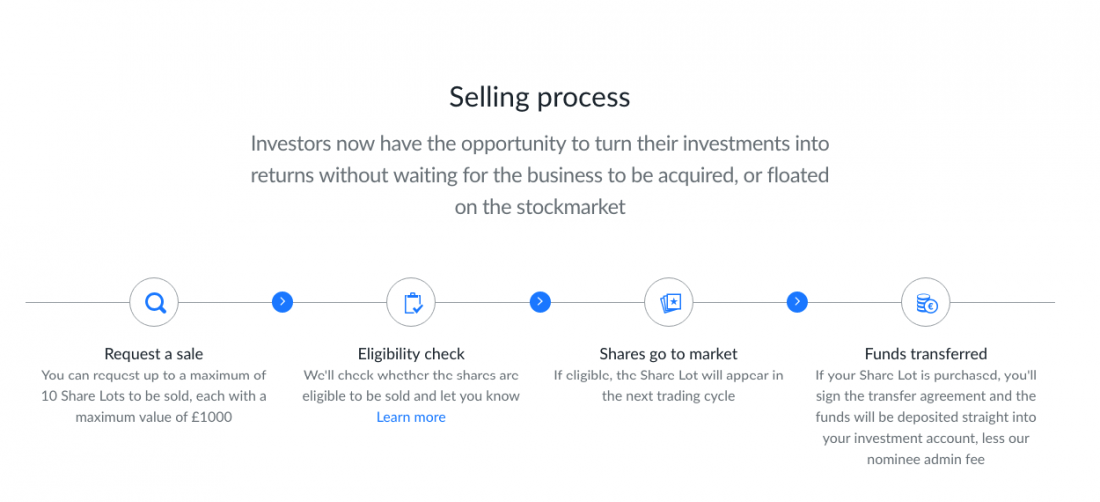
Crowdcube’s “stock market
The biggest competitor of the Seedrs secondary market, Crowdcube also tried the luck in creating a ‘stock market’ for equity investments and announced the launch of its beta version not so long ago.
Mettrr Technologies was the first company to experiment with selling its shares.
The startup successfully raised seed capital of £100,000 via Crowdcube crowdfunding platform in 2012. Mettrr Technologies offers ‘Do It For Me’ website development services and has proved to be pretty successful. In 2016 the guys earned their first £1m.
In the spring of 2017, the portal offered early investors to sell their shares on the secondary market. The first buyers of the company’s stakes were outside angels interested in acquiring a part of its equity. Although the transactions did not exceed £50,000, the Crowdcube team expects their innovation to be a real breakthrough.
PeerRealty and its CFX secondary market
The CFX, an American trading platform for alternative investments, has been recently purchased by PeerRealty.
The market functions both as an auction and an open market. Several backers can bid their prices for each transaction and the seller chooses the best of them.
In addition, buyers can purchase shares immediately at “buy now prices.

It’s a backer who decides whether to buy a particular shares lot, and the CFX Markets provides them only with relevant information about the property and its holders.
The company charges a 3.5% fee to shareholders, and 2.5% to buyers based upon prices deals are closed at.
Currently, the secondary market is open only for accredited investors.
Benefits for everyone
Secondary markets for equity securities are quite complex.
Maybe, this is a reason why there is no organised marketplace yet.
An effective market has to work for all the parties – businesses, investors and crowdfunding platforms.
The buying and selling process should be transparent and straightforward and have as minimum caveats as possible.
A new wave of secondary markets appearing in the crowdfunding sector creates the conditions for all the participants to receive substantial gains.
How does it work for businesses?
A secondary market gives you as a business owner a chance to:
- attract new investors well ahead of the start of a fundraising campaign;
- allow your investors to withdraw the funds if they feel the need;
- merely observe the whole process because a broker, being a nominee structure, will take the job on transactions.
It is noteworthy to mention that not all the shares will be open for trading according to the eligibility requirements.
Even if the shares of your company appear on the secondary market, the number of closed deals will depend on the supply-demand ratio.
Trading opportunities for investors
If you’re a buyer, you can:
- get access to companies’ shares outside of a crowdfunding round;
- have an opportunity to purchase more rights for a company’s property you already possess;
- avoid any fees when investing.
If you’re a seller, you can:
- liquidate some of your investments and convert them into cash without waiting until the exit time or when the business is acquired;
- make your portfolio more balanced and well-diversified;
- deposit funds on your investment account.
However, don’t forget that secondary trading is just a plus, and it’s advisable to keep your shares up to the exit event because there is no certainty that you will buy or sell them during trading sessions.
What does it mean for crowdfunding platforms?
The opportunities you gain as a middleman:
- satisfy the demand of existing clients in secondary buying and selling stakes;
- involve more potential backers and startups to your fundraising campaigns;
- increase your revenue through fees collected from external investors;
- make the shares and stakes traded on your market more liquid and profitable.
Due to a sad statistic of projects that failed on their way, you must remember that the launch of a secondary market for crowdfunding investors is a big deal.
It requires considerable efforts, sufficient people and money resources and in-depth research.
The example of Seedrs and its peers shows that you should take slow, careful steps and remember that there is always a room for improvement.
Lenderkit – a white-label solution with a secondary market for equity crowdfunding
Our development team has created a solution for fundraising companies intending to integrate a secondary market into their platforms.
LenderKit is a perfect fit for all crowdfunding niches – real estate fundraising companies, crowdlending and equity investing businesses.
LenderKit toolkit consists of:
- admin dashboard where platform owners can monitor new members and visitors, control payments and cash flows, analyse the business performance, etc.;
- integrated AML/KYC checks for vetting potential borrowers and backers;
- user-friendly CMS that allows admins efficiently manage content, edit and update websites;
- compatibility with third-party plugins for growing and extending any crowdfunding business;
- a secondary market that will give you a competitive advantage over rivals;
- responsive and mobile-optimised design that looks and functions flawlessly in every environment.
How a secondary market works:
1. An investor chooses an investment for trading in their dashboard.
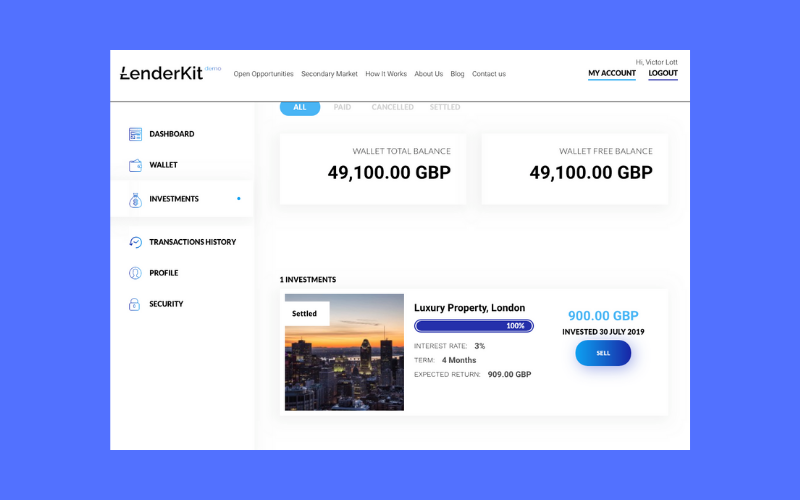
2. Enters the price for investment: the system can recommend the price for a sale.
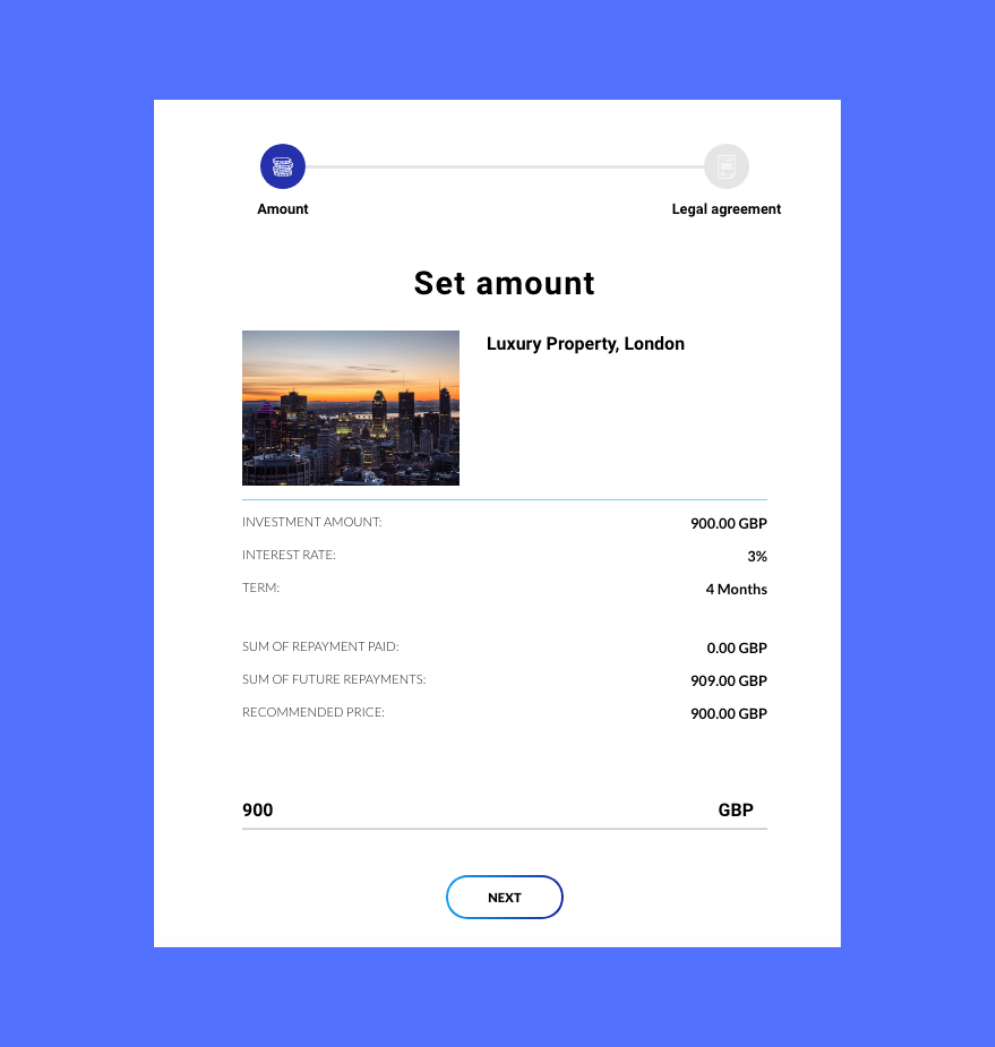
3. The investor signs the contract for share trading and the investment becomes available on the market. The backer sees the trading investment in their dashboard.
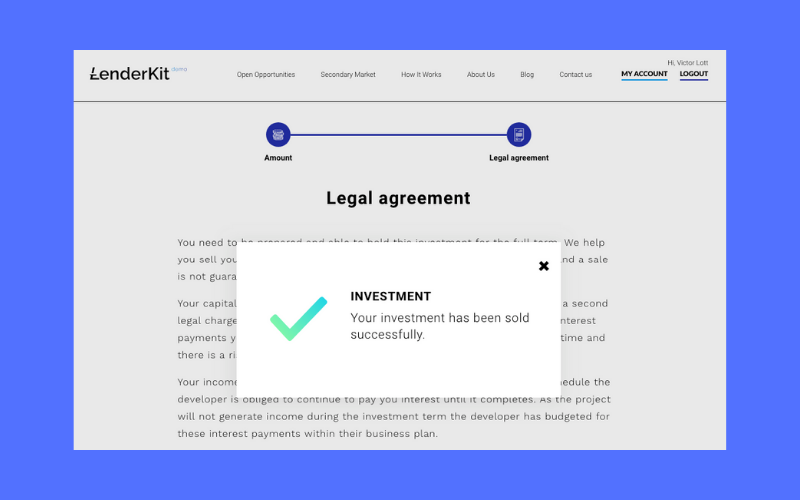
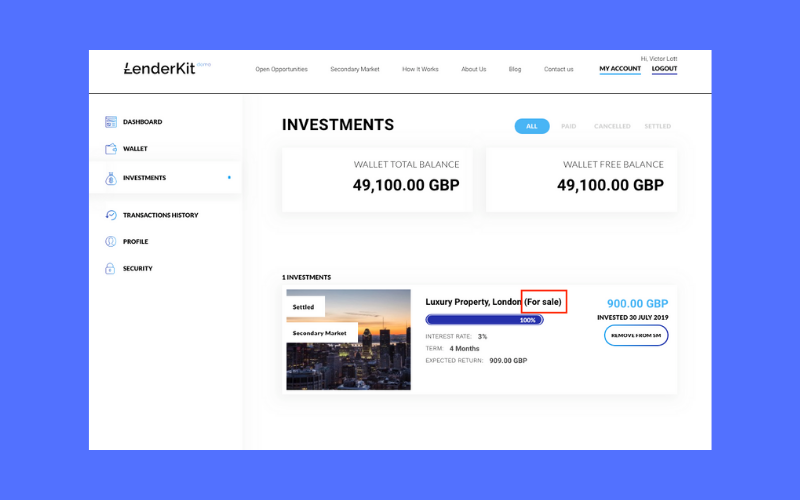
4. Anyone willing to purchase the investment can do it easily by clicking Buy. The investment is purchased in a bundle with all the repayments.
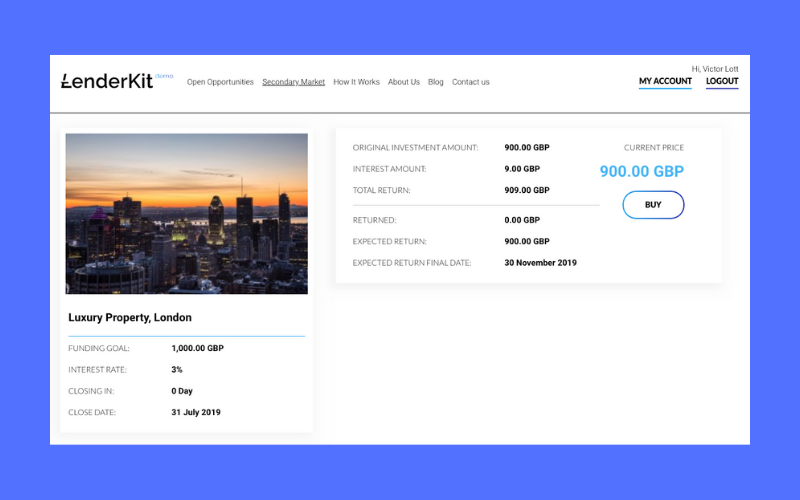
We’ve also implemented a secondary market for crowdfunded properties on CapitalRise platform which works in a similar way.
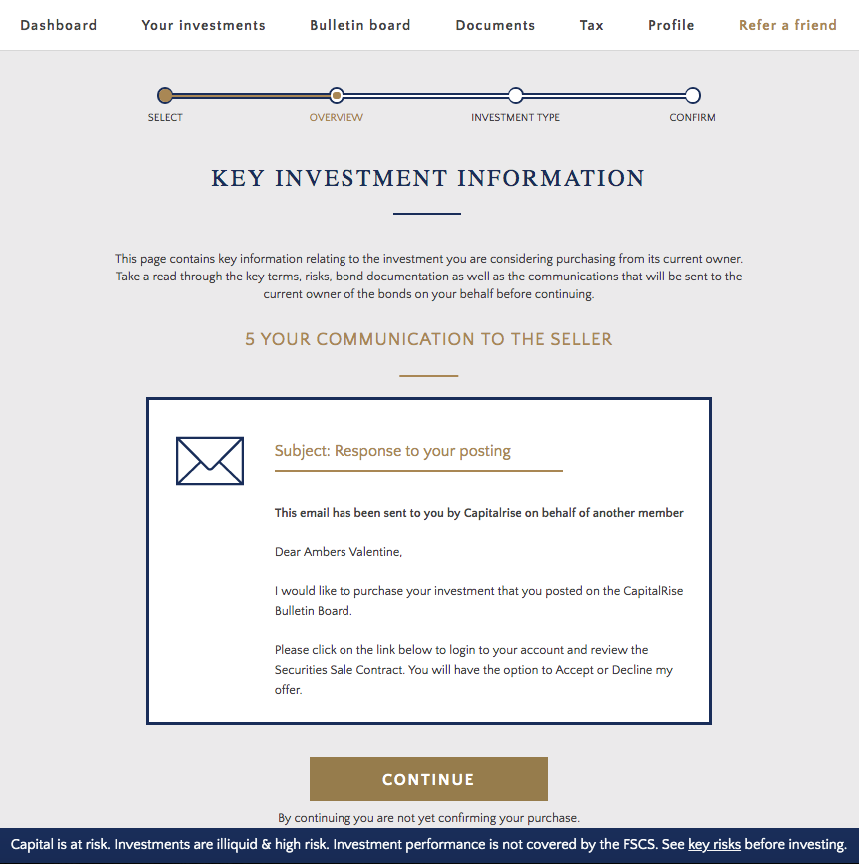
CapitalRise is a portal offering equity crowdfunding for investors and backers.
Perspectives of the secondary market
The industry tends to demonstrate poor results regarding successful exits of the deals.
Solving this problem will largely depend on the appearance of the secondary market, at least partially.
Thanks to the actions taken by Seedrs and other crowdfunding intermediaries, those investors who used to worry about their funds stuck will unleash their investment potential.
For many experts, this step is signalling that a new era of crowdfunding is about to begin.
However, there are still a number of limitations that prevent the secondary market from growing actively.
An effective market has to meet the requirements of minimum information asymmetry, operational costs, and a high level of standardisation.
Unfortunately, the beta versions of equity crowdfunding secondary markets existing today are not fully compatible with these standards.
Constraints of equity crowdfunding secondary markets
- Early versions of Seedrs’ and Crowdcube marketplaces are accessible to the sellers and buyers who are already the clients of these platforms.
- The same thing happens with businesses. Only those companies which crowdfunded with the brokers earlier will be listed on the secondary market.
- Even though the websites fix prices through a demand-supply mechanism, bids will be under their control.
- Investors will not be able to trade whenever they want as there will be predefined trading time periods.
- Only certain companies will be entitled to sell their assets according to the eligibility criteria.
- The legislative framework for secondary markets is still at the development stage, which explains why there is no single organised market yet.
Both companies claim that these nuisances are short-term and will be overcome soon.
The testing period is vitally important to diagnose the strengths and weaknesses and determine the development paths.
FCA states that although some websites are equipped with secondary markets, not all the investments can be easily cashed in. In addition, some securities can’t be traded on secondary markets since they’re not transferable.
The SEC, in its turn, believes the lack of secondary securities trading is caused by the unpopularity of these activities among brokers, borrowers and backers.
Final thoughts
So, all in all, the introduction of secondary markets in the crowdfunding world is going to be a real breakthrough.
Despite the fact that it only concerns equity deals now, it will spread to debt deals and p2p lending as well.
The primary benefit of these secondary markets is the increase in the liquidity of crowdfunded securities.
The global aim of all the platforms who decided to launch secondary markets is to allow investors to trade all shares without an exception and list all businesses no matter whether they crowdfunded before or not.
We hope that this post has stimulated your interest in this relevant topic.
If you’d like to know more about this subject or you have fresh ideas, don’t hesitate to contact us.

